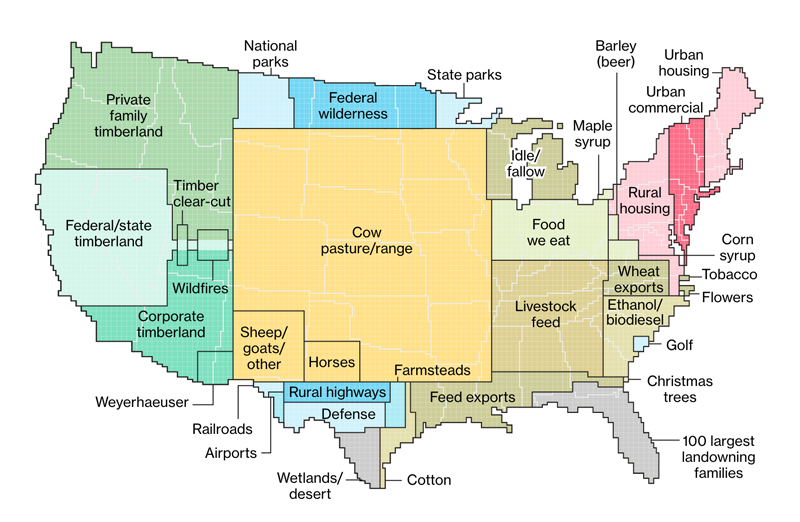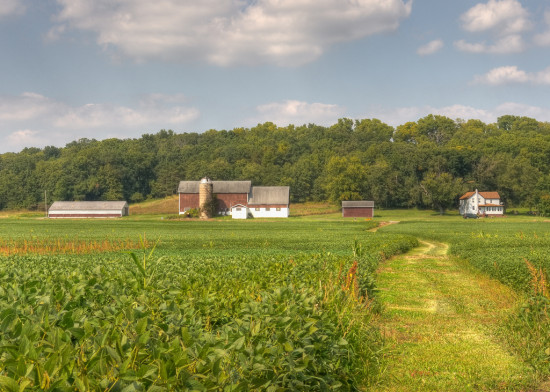Bloomberg has released a fascinating look at how America uses her land. I found the information on agriculture quite interesting:
“Agricultural land takes up about a fifth of the country. Yet the actual land area used to grow the food Americans eat is much smaller—only about the size of Indiana, Illinois and half of Iowa combined. More than a third of the entire corn crop is devoted to ethanol production. Most cropland is used for livestock feed, exports or is left idle to let the land recover. While the U.S. benefits from an overall agricultural trade surplus, Americans imported 15 percent of their food and beverage products in 2016. More than 30 percent of the fresh fruits and vegetables Americans consume come from other countries, predominantly Mexico and Canada. The amount of U.S. land used to produce citrus fruits alone is larger than Rhode Island.”

30% of fruit and vegetables coming from overseas? Sounds like an opportunity for local farmers to me, especially if President Trump continues his push to reduce trade deficits and restore production to the US.
Even without protective trade barriers, local is hot. I considered growing papaya in North Florida and selling them as “locally produced, pesticide free,” but never got around to it. There are all kinds of niche opportunities to make a little cash with agriculture. You’ll find that many people would rather support a local farmer than buy from Mexico or Chile or even a large supermarket. Marketing is key, though. I did very well selling plants from my nursery because I answered questions, gave away small plants to children, talked with everyone that walked by and published regular gardening articles in a local magazine.
I once went to a plant show and brought in around a thousand dollars. I asked another vendor how she and her husband had done and she said “lousy.”
I know why, too. I took a break at one point and left my booth in the hands of a very capable assistant, then walked over to their booth to say hi. They had a nice collection of rare native species, but the husband was manning the booth and said nothing when I walked up. He sat there, dark sunglasses on, just staring.
“Hello,” I said eventually.
“Hey,” he replied. “You ever raise pigs?”
Nope, that won’t sell plants. You have to force yourself to stay focused on the event, focused on people, and giving them what they want. They are there to buy plants – all you have to do is get them interested in your plants. It’s the same thing with produce. Show off some purple carrots or an exceptional winter squash. Ask if they do any gardening. Share with them that you’re growing pesticide-free or that your eight-year-old grew the ginger for sale. You’ll do great.


5 comments
An absolutely fascinating post. The visual of it registered on a much a deeper level than an article by itself ever could. Kudos for sharing it. Kudos to whoever came up with the visual. What an effective communication tool. I literally spent ten minutes studying the breakdown for each listing. I guess that makes me a little bit of a nerd. Thanks.
Yeah, it really is fascinating. What I’d like to see is a chart showing government controlled land vs. private land.
Depending on your view of taxation, you could make the case that all land is government controlled to some degree or another. Then there is the consideration of government regulation. But that is a rant for another day.
I agree. If they’re taxing the land, you’re paying rent to the government to live on it. If you don’t pay, they take it – which means they own it. However, there’s more control than that, particularly when you go out west. Millions of acres of land completely tied up by the feds.
Thanks for sharing that interesting map. I didn’t realize the great plains were known for grazing cattle. I expected them to be more known for growing wheat. In Missouri where I live, the Ozarks make it tough for growing plants, so cattle definitely reigns supreme for farming.
Frank – owner of Tree Service Jefferson County | https://www.treeservice-jeffersoncounty.com
Comments are closed.